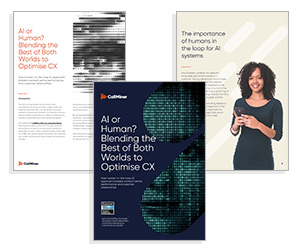CallMiner breaks down the core technologies driving that change, the real challenges companies face during implementation, and what it takes to get it right.
AI has had a significant impact on how contact centres operate. What used to require long wait times and repetitive manual processes can now be handled instantly with automation, predictive tools, and natural language systems, all of which impact the customer experience.
But implementing AI in a contact centre isn’t just a technology upgrade – it’s a shift in how service is delivered.
Key AI Technologies Transforming CX in Contact Centres & The Benefits
AI innovations are creating more efficient, responsive, and personalized customer experiences. Here’s a look at the key AI technologies that are transforming CX in contact centres today.
Chatbots & Virtual Assistants
Chatbots and virtual assistants handle customer inquiries instantly, at any time of day. They reduce wait times and free up live agents to handle more complex issues.
These systems can manage FAQs, reset passwords, schedule appointments, and even process simple transactions. With consistent responses and 24/7 availability, they help maintain customer satisfaction while lowering support costs.
Natural Language Processing (NLP)
Natural language processing interprets what customers are saying and how they’re saying it. It breaks down sentences to extract intent, identify keywords, and detect sentiment.
This allows systems to route queries accurately and respond in a human-like manner. NLP also enables multilingual support, auto-tagging of requests, and more effective escalation when needed.
Predictive Analytics
Predictive analytics technology anticipates customer needs before they arise. By analysing past behaviour, it can forecast churn, flag high-value customers, and suggest next-best actions.
In the contact center, predictive analytics helps predict staffing needs, prioritize support tickets, and deliver personalized offers. Predictive analytics shifts CX from reactive to proactive, often resolving issues before a customer even reaches out.
Voice AI & Speech Recognition
These technologies convert spoken language into text (also known as speech-to-text), enabling faster call routing and streamlined interactive voice response (IVR) experiences. Speech recognition understands accents, tone, and context, allowing customers to speak naturally without pressing buttons.
Speech recognition also supports agent-assist features, such as real-time transcription and suggested responses, improving accuracy and efficiency during live interactions.
Conversational AI
Conversational AI blends NLP, machine learning, and context awareness to create more fluid, human-like exchanges.
Unlike basic chatbots, it maintains context across multiple messages, handles interruptions, and adapts as the conversation evolves. It enables richer self-service and reduces the time to resolution without frustrating customers.
Robotic Process Automation (RPA)
RPA handles repetitive, rule-based tasks behind the scenes. It logs tickets, updates CRMs, checks inventory, and processes refunds instantly and without errors.
By integrating with multiple systems, RPA allows agents to spend more time on relationship-building and less on data entry or manual workflows.
Sentiment and Emotion Analysis
Sentiment and emotion analysis scans words, tone, and pacing to detect how a customer feels (frustrated, neutral, satisfied, etc.). This data triggers real-time actions like escalation to a live agent or adjusting the tone of automated replies.
It also gives managers insight into trends across interactions, enabling better coaching, training, and process improvements.
Challenges & Considerations For AI For CX in Contact Centres
While AI boosts efficiency and quality in the contact centre, it’s not without challenges. Successful implementation requires more than just plugging in new tools; it demands careful planning, system upgrades, and a clear understanding of customer expectations.
From technical limitations to trust issues, these challenges can shape AI’s effectiveness in real-world service environments. Let’s explore some common challenges and best practices for overcoming them.
Integration Complexity
AI doesn’t plug neatly into every tech stack. Many contact centres still rely on outdated infrastructure built long before automation was a consideration.
In such cases, integrating modern AI tools often means rebuilding systems from the ground up or bolting new tech onto rigid, legacy frameworks.
That comes with cost, downtime, and the risk of introducing friction into workflows that are already stretched thin. Without a clear plan for interoperability, even the most advanced AI tools can become dead weight.
Data Privacy & Security
AI thrives on data, but that data comes with responsibility. Contact centres handle sensitive information daily, from personal identifiers to financial records.
Feeding this into AI systems raises serious privacy concerns, especially under strict regulations like GDPR or CCPA. Every interaction logged must be done with encryption, access controls, and audit trails in place. One misstep can result in not only legal costs but also damage to a company’s reputation.
Balancing AI & Human Touch
Automation isn’t always the right answer. AI is efficient, but it can’t match human nuance in emotionally charged or high-stakes scenarios. Knowing when to pass the baton is key.
Contact centers need clear escalation paths that let live agents step in seamlessly when empathy, judgment, or discretion are required. Over-automation, especially without a fallback, can frustrate customers and damage trust.
Customer Acceptance
Not everyone wants to talk to a machine. Some customers don’t trust AI to understand their problem, while others simply prefer the reassurance of a human voice.
While this is becoming less of a concern as consumers are increasingly exposed to AI-driven systems in every facet of modern life, it may still be a point of frustration for some customers.
If AI becomes a wall instead of a gateway, people will find ways around it – or abandon the interaction altogether. Successful adoption means giving users a choice, not a mandate. Let them opt into automation, not feel trapped by it.
Best Practices For Successful AI Implementation in Contact Centres
Implementing AI in a contact centre isn’t just about the tools – it’s about how they’re used. Rushed deployments and poor oversight can backfire, eroding both customer trust and operational efficiency.
The following best practices help ensure AI strengthens service instead of complicating it, addressing key challenges from integration to customer acceptance.
Start Small
Rolling out AI across a contact centre all at once is risky. Starting with a focused pilot, such as a chatbot handling FAQs or basic account queries, helps teams evaluate performance without disrupting core operations.
This approach minimizes integration headaches and reduces the risk of system-wide failures. It also allows teams to gather feedback, refine workflows, and address user resistance early on. Starting small directly tackles integration complexity and builds internal confidence before scaling up.
Train AI Continuously
Static AI systems degrade over time. Customer language evolves, new products launch, and unforeseen queries emerge. Feeding real-world interactions back into the model ensures AI responses stay sharp, relevant, and accurate.
Without regular training, even a high-performing AI will stumble –misunderstanding intent, missing key context, or giving outdated answers.
Ongoing training addresses the challenge of balancing automation with quality, ensuring AI doesn’t become a liability as conditions change.
Monitor & Optimize
Launching AI isn’t the finish line – it’s the starting point. Contact centres must actively track key performance metrics like CSAT, first contact resolution (FCR), and escalation rates to gauge effectiveness.
These insights show where AI is succeeding, where it’s falling short, and how it’s impacting the overall customer journey.
Without this data, poor experiences go unnoticed, and costly mistakes repeat. Monitoring combats blind spots and drives continuous improvement.
Human-AI Collaboration
AI should act as an assistant, not a gatekeeper. It can handle the bulk of repetitive tasks, route queries, and surface relevant info – but it shouldn’t replace human agents in moments that demand empathy or judgment.
Designing systems that allow seamless handoffs ensures customers aren’t left talking to a bot when they need a real person.
This best practice solves the challenge of maintaining a human touch and avoids the trap of over-automation that alienates customers.
This blog post has been re-published by kind permission of CallMiner – View the Original Article
For more information about CallMiner - visit the CallMiner Website
Call Centre Helper is not responsible for the content of these guest blog posts. The opinions expressed in this article are those of the author, and do not necessarily reflect those of Call Centre Helper.
Author: CallMiner
Reviewed by: Rachael Trickey
Published On: 30th Apr 2025 - Last modified: 1st May 2025
Read more about - Guest Blogs, CallMiner






 CallMiner is the leading cloud-based customer interaction analytics solution for extracting business intelligence and improving agent performance across all contact channels.
CallMiner is the leading cloud-based customer interaction analytics solution for extracting business intelligence and improving agent performance across all contact channels. 












